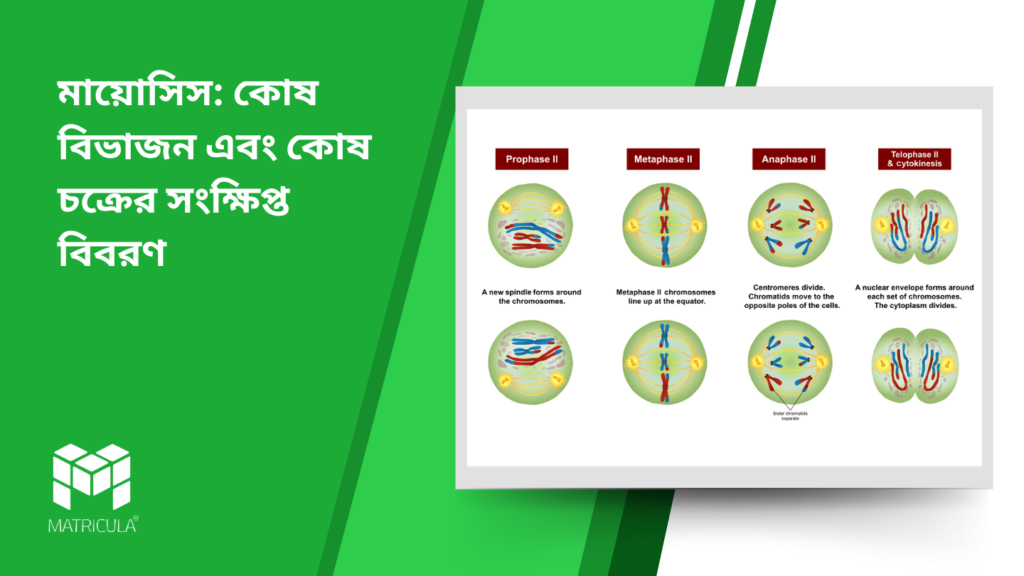Introduction
Cell division is a fundamental biological process that ensures growth, reproduction, and genetic continuity in living organisms. In multicellular organisms, two types of cell division occur—mitosis and meiosis. While mitosis leads to the formation of genetically identical daughter cells, meiosis is a specialized process that reduces the chromosome number by half, ensuring genetic diversity in sexually reproducing organisms. This article provides a detailed yet easy-to-understand explanation of Meiosis-I, Meiosis-II, and the process of crossing over.
Meiosis: An Overview
Meiosis is a two-step division process that occurs in germ cells (sperm and egg cells), reducing the chromosome number from diploid (2n) to haploid (n). This ensures that when fertilization occurs, the normal chromosome number of the species is maintained. The two successive divisions of meiosis are:
- Meiosis-I (Reductional Division) – Reduces the chromosome number.
- Meiosis-II (Equational Division) – Maintains the haploid number by dividing sister chromatids.
Let’s explore these stages in detail.
Meiosis-I: The First Division
Meiosis-I is known as reductional division because it reduces the chromosome number from diploid to haploid. It consists of the following phases:
1. Prophase-I
- The longest and most complex phase of meiosis.
- Chromosomes condense and become visible.
- Homologous chromosomes (one from each parent) pair up in a process called synapsis, forming bivalents.
- Crossing over occurs at regions called chiasmata, allowing the exchange of genetic material between homologous chromosomes.
2. Metaphase-I
- Homologous chromosome pairs align at the metaphase plate.
- The arrangement is random, leading to independent assortment, which increases genetic variation.
3. Anaphase-I
- Homologous chromosomes are pulled apart to opposite poles by spindle fibers.
- Sister chromatids remain attached, unlike in mitosis.
4. Telophase-I and Cytokinesis
- Nuclear membranes may reappear around the separated chromosomes.
- The cytoplasm divides, forming two haploid daughter cells, each containing half the original chromosome number.
Meiosis-II: The Second Division
Meiosis-II is an equational division similar to mitosis, where the sister chromatids separate without further reducing chromosome number. It includes the following phases:
1. Prophase-II
- Chromosomes condense again.
- Spindle fibers begin to form.
2. Metaphase-II
- Chromosomes align at the center of the cell.
3. Anaphase-II
- Sister chromatids are pulled apart toward opposite poles.
4. Telophase-II and Cytokinesis
- Nuclear membranes reappear around the chromosomes.
- The cytoplasm divides, resulting in four haploid daughter cells with unique genetic combinations.
Crossing Over and Its Process
One of the most significant events in meiosis is crossing over, which occurs during Prophase-I in a sub-stage called Pachytene. This process enhances genetic diversity by exchanging genetic material between homologous chromosomes.
Steps in Crossing Over:
- Synapsis: Homologous chromosomes pair up and form structures called tetrads.
- Chiasma Formation: Non-sister chromatids overlap, forming chiasmata.
- Exchange of Genetic Material: DNA segments between homologous chromosomes are exchanged.
- Separation: The homologous chromosomes separate while carrying newly recombined genes.
This process creates genetic variation, ensuring that offspring inherit different combinations of parental traits.
Conclusion
Meiosis plays a crucial role in sexual reproduction by producing haploid gametes and promoting genetic diversity through crossing over and independent assortment. This process is essential for evolution and the survival of species. Understanding meiosis helps in comprehending various genetic principles and abnormalities related to cell division.
By studying Meiosis-I, Meiosis-II, and crossing over, students can gain insights into the mechanisms behind inheritance and variation in living organisms.
Key Takeaways:
✔ Meiosis reduces the chromosome number by half, ensuring genetic stability in sexually reproducing organisms.
✔ Meiosis-I involves the separation of homologous chromosomes, while Meiosis-II separates sister chromatids.
✔ Crossing over in Prophase-I increases genetic variation.
✔ The result of meiosis is four genetically unique haploid daughter cells.
মিয়োসিস: কোষ বিভাজন এবং কোষ চক্রের সংক্ষিপ্ত বিবরণ
ভূমিকা
কোষ বিভাজন হল একটি গুরুত্বপূর্ণ জৈবিক প্রক্রিয়া যা জীবের বৃদ্ধি, প্রজনন এবং বংশগত ধারাবাহিকতা নিশ্চিত করে। জীবের মধ্যে প্রধানত দুটি ধরণের কোষ বিভাজন ঘটে—মাইটোসিস (Mitosis) এবং মিয়োসিস (Meiosis)। মাইটোসিসে দুটি অভিন্ন কন্যা কোষ (Daughter Cells) তৈরি হয়, কিন্তু মিয়োসিসে ক্রোমোজোম সংখ্যা অর্ধেক হয়ে যায়, যা যৌন প্রজননে জিনগত বৈচিত্র্য নিশ্চিত করে।
এই প্রবন্ধে মিয়োসিস-I, মিয়োসিস-II এবং ক্রসিং ওভার (Crossing Over) প্রক্রিয়া সম্পর্কে সহজ ও বিস্তারিত ব্যাখ্যা দেওয়া হল।
মিয়োসিস: সংক্ষিপ্ত পরিচয়
মিয়োসিস হল দুটি ধাপে সম্পন্ন হওয়া বিভাজন প্রক্রিয়া যা গ্যামেট (Gamete) বা জনন কোষে সংঘটিত হয় এবং ডিপ্লয়েড (2n) থেকে হ্যাপ্লয়েড (n) কোষ তৈরি করে। এটি দুটি ভাগে বিভক্ত:
- মিয়োসিস-I (Reductional Division) – ক্রোমোজোম সংখ্যা কমিয়ে দেয়।
- মিয়োসিস-II (Equational Division) – বোন ক্রোমাটিডগুলিকে (Sister Chromatids) বিভক্ত করে।
চলুন প্রতিটি ধাপ বিস্তারিতভাবে আলোচনা করা যাক।
মিয়োসিস-I: প্রথম বিভাজন
মিয়োসিস-I কে হ্রাসকারী বিভাজন (Reductional Division) বলা হয়, কারণ এটি ডিপ্লয়েড ক্রোমোজোম সংখ্যা কমিয়ে হ্যাপ্লয়েড তৈরি করে। এর বিভিন্ন ধাপ:
1. প্রোফেজ-I (Prophase-I)
- মিয়োসিসের সবচেয়ে দীর্ঘ ও জটিল ধাপ।
- ক্রোমোজোম ঘনীভূত (Condensed) হয়ে দৃশ্যমান হয়।
- একই বৈশিষ্ট্যের হোমোলোগাস ক্রোমোজোম (Homologous Chromosomes) জোড়া বাঁধে, যা সিন্যাপসিস (Synapsis) নামে পরিচিত এবং বাইভ্যালেন্ট (Bivalent) গঠন করে।
- ক্রসিং ওভার (Crossing Over) ঘটে, যা জিনগত বৈচিত্র্য বৃদ্ধি করে।
2. মেটাফেজ-I (Metaphase-I)
- হোমোলোগাস ক্রোমোজোম জোড়াগুলি কোষের মাঝখানে সারিবদ্ধ হয়।
- স্বাধীন বিন্যাস (Independent Assortment) ঘটে, যা জিনগত বৈচিত্র্য বৃদ্ধি করে।
3. অ্যানাফেজ-I (Anaphase-I)
- হোমোলোগাস ক্রোমোজোম জোড়া পৃথক হয়ে বিপরীত মেরুর দিকে টানা হয়।
- বোন ক্রোমাটিডগুলো সংযুক্ত থাকে, যা মাইটোসিস থেকে এটিকে ভিন্ন করে তোলে।
4. টেলোফেজ-I এবং সাইটোকাইনেসিস (Telophase-I & Cytokinesis)
- নিউক্লিয়ার আবরণ পুনরায় গঠিত হতে পারে।
- সাইটোপ্লাজম বিভাজিত হয়ে দুটি হ্যাপ্লয়েড কন্যা কোষ তৈরি হয়।
মিয়োসিস-II: দ্বিতীয় বিভাজন
মায়োসিস-II হল সমান বিভাজন (Equational Division), যা মাইটোসিসের মতো বোন ক্রোমাটিডগুলিকে বিভক্ত করে। এর ধাপগুলি নিম্নরূপ:
1. প্রোফেজ-II (Prophase-II)
- ক্রোমোজোম আবার ঘনীভূত হয়।
- স্পিন্ডল ফাইবার তৈরি হয়।
2. মেটাফেজ-II (Metaphase-II)
- ক্রোমোজোম কোষের কেন্দ্রে সারিবদ্ধ হয়।
3. অ্যানাফেজ-II (Anaphase-II)
- বোন ক্রোমাটিডগুলো আলাদা হয়ে বিপরীত মেরুর দিকে সরে যায়।
4. টেলোফেজ-II এবং সাইটোকাইনেসিস (Telophase-II & Cytokinesis)
- নিউক্লিয়ার আবরণ পুনরায় গঠিত হয়।
- চারটি হ্যাপ্লয়েড কন্যা কোষ তৈরি হয়, প্রতিটিতে জিনগত বৈচিত্র্য থাকে।
ক্রসিং ওভার এবং এর প্রক্রিয়া
মিয়োসিসের সবচেয়ে গুরুত্বপূর্ণ ঘটনা হল ক্রসিং ওভার, যা প্রোফেজ-I এর পাকাইটিন (Pachytene) পর্যায়ে ঘটে। এই প্রক্রিয়া জিনগত বৈচিত্র্য সৃষ্টি করে এবং প্রজাতির বিবর্তনে গুরুত্বপূর্ণ ভূমিকা পালন করে।
ক্রসিং ওভার এর ধাপসমূহ:
- সিন্যাপসিস (Synapsis): হোমোলোগাস ক্রোমোজোম একত্রিত হয়ে টেট্রাড (Tetrad) গঠন করে।
- কিয়াজমা গঠন (Chiasma Formation): অ-মৌলিক (Non-sister) ক্রোমাটিডগুলির মধ্যে কিছু অংশ ওভারল্যাপ করে।
- জিনগত উপাদান বিনিময় (Exchange of Genetic Material): হোমোলোগাস ক্রোমোজোমের মধ্যে DNA আদান-প্রদান হয়।
- বিচ্ছেদ (Separation): হোমোলোগাস ক্রোমোজোম আলাদা হয়ে যায় এবং নতুন জিনগত বৈচিত্র্য নিয়ে পৃথক হয়।
এই প্রক্রিয়ার মাধ্যমে নতুন বৈশিষ্ট্যের সৃষ্টি হয়, যা প্রাকৃতিক নির্বাচনে গুরুত্বপূর্ণ ভূমিকা রাখে।
উপসংহার
মায়োসিস যৌন প্রজননে গুরুত্বপূর্ণ ভূমিকা পালন করে, কারণ এটি হ্যাপ্লয়েড গ্যামেট তৈরি করে এবং জিনগত বৈচিত্র্য নিশ্চিত করে। ক্রসিং ওভার এবং স্বাধীন বিন্যাসের (Independent Assortment) মাধ্যমে জিনগত বিভিন্নতা বৃদ্ধি পায়, যা বিবর্তনের জন্য অপরিহার্য।
এই প্রবন্ধের মাধ্যমে মিয়োসিস-I, মিয়োসিস-II এবং ক্রসিং ওভার সম্পর্কে একটি সুস্পষ্ট ধারণা পাওয়া গেল, যা মাধ্যমিক পরীক্ষার জন্য গুরুত্বপূর্ণ।
মূল বিষয়সমূহ:
✔ মিয়োসিস ক্রোমোজোম সংখ্যা কমিয়ে যৌন প্রজননে জিনগত স্থিতিশীলতা বজায় রাখে।
✔ মিয়োসিস-I তে হোমোলোগাস ক্রোমোজোম পৃথক হয়, আর মিয়োসিস-II তে বোন ক্রোমাটিড বিভক্ত হয়।
✔ ক্রসিং ওভার প্রোফেজ-I তে ঘটে এবং এটি জিনগত বৈচিত্র্য বৃদ্ধি করে।
✔ মিয়োসিসের ফলে চারটি অনন্য হ্যাপ্লয়েড কন্যা কোষ তৈরি হয়।




